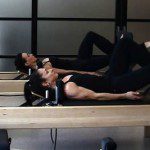People with Parkinson’s Disease (PD) have trouble controlling the way they move. They develop tremors, find it difficult to stay balanced, and instead of moving may do just the opposite – become stiff and rigid. They may have to take drugs – like levodopa – just to be able to do normal, everyday activities. But now some individuals with PD are finding a way to move more easily that doesn’t involve taking more drugs. Instead, they’re doing Pilates exercises.
Pilates exercises use very small movements, and are based on the theory that it’s more important to move properly once than to move incorrectly many times. They’re also gentle; many are done either sitting or lying down, with only partial weight-bearing. This makes them ideal for rehabilitation, and in fact they’re sometimes recommended for other conditions, like multiple sclerosis, fibromyalgia, and scoliosis.
One of the biggest advantages of Pilates, though, is the flexibility of its routines. Exercises can be tailored to meet the individual needs of the people doing them.
Pilates has been recommended for Parkinson’s before. However, a new program at the Parkinson’s Center of the Oregon Health and Science University has proven to be a real benefit for its participants, who have found it helped them be stronger, more flexible, and more balanced. The program, started in early 2006, is so popular that it currently has a waiting list. Right now the only documentation of the benefits of Pilates to patients with PD is in the testimonials of the people who do it.
But OHSU is planning to do research on the effects of exercise on Parkinson’s Disease symptoms. So far, their studies with rats who have very little dopamine (the main characteristic of PD) have shown that exercise – in this case, on a treadmill – can help the return of some muscle movement. But they have no studies with humans – yet.
One of the participants of the OHSU program may have given the best testimonial of all when he said that doing Pilates has helped him be more positive. And a positive attitude may be the best way to live with a chronic disease like Parkinson’s.


